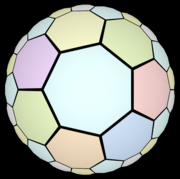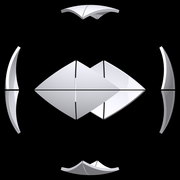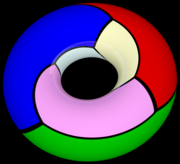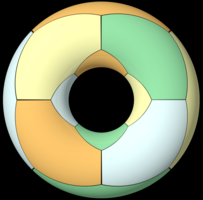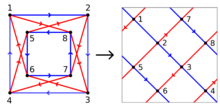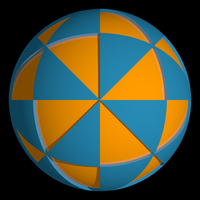User:PSL27
Hi. My name is Mike Grady. I'm interested in the visual and computational exploration of ideas in group theory. This includes Cayley graphs, group presentations, and closely related subjects such as symmetric graphs and regular maps.
The prehistory of Cayley graphs and regular maps includes the discovery of the Platonic and Archimedean solids, Kepler's discovery of what we now call higher genus maps, Hamilton's presentation of the Icosahedral group and Klein's platonic tessellation of the surface of genus 3.
Groups may be represented in a variety of interesting and powerful ways, such as permutation representations, matrix representations and by group presentation. They may also be represented as the automorphism group of geometric objects such as polyhedron, graphs or regular maps. A great advantage of this form of representation is, as A.T. White has pointed out, "that many results of the general theory can be readily visualized or modeled, so that students are constantly reassured that what they are doing has meaning and is more than a formal manipulation of symbols".
Hyperbolic Tessellations[edit]
-
Partial {7,3} hyperbolic tiling of the hyperboloid as seen in Beltrami-Klein perspective.
-
Animation of partial {7,3} hyperbolic tiling of the hyperboloid rotating into the Beltrami-Klein perspective.
-
Partial {7,3} hyperbolic tiling of the hyperboloid.
-
Partial {7,3} hyperbolic tiling of the hyperboloid rotated into Poincare perspective.
-
Animation of a partial {7,3} hyperbolic tiling of the hyperboloid rotated into the Poincare perspective.
Regular Maps of Genus 0[edit]
-
Regular spherical map {3,3}.
-
Regular spherical map {4,3}.
-
Regular spherical map {3,4}.
-
Regular spherical map {5,3}.
-
Regular spherical map {3,5}.
Regular Maps on the Projective Plane[edit]
-
The Petersen graph and associated map embedded in the projective plane. Opposite points on the circle are identified yielding a closed surface of non-orientable genus 1.
-
The complete graph K6 and associated map embedded in the projective plane. Opposite points on the circle are identified yielding a closed surface of non-orientable genus 1.
Regular Maps of Higher Genus[edit]
-
The degree 7 Klein graph and associated map embedded in an orientable surface of genus 3.
Polyhedral Groups[edit]
-
Fundamental tiling of the sphere for the full icosahedral group Ih. The rotation subgroup is shown in white tiles, its coset in blue tiles.
-
Orbit of a fundamental tile under action of the rotation group I, a subgroup of the full icosahedral group Ih.
-
This animation shows the orbit of a fundamental tile of the full icosahedral group Ih under action of its rotation subgroup I.
-
Orbit of a fundamental tile under action of the tetrahedral group, Th, a subgroup of the full icosahedral group Ih.
-
The five cosets of Th, a subgroup of the full icosahedral group Ih, shown in different colors.
Tiling the Torus[edit]
-
The Heawood graph and associated map embedded in the torus.
-
The Pappus graph and associated map embedded in the torus.
-
Animation detailing the embedding of the Pappus graph and associated map in the torus.
-
Cayley graph for the symmetries of the toroidal embedding of the Pappus graph. Opposite edges of this image should be identified, yielding the torus.
Group theory, geometry, symmetric graphs and regular maps[edit]
-
Orbit of a fundamental spherical triangle (marked in red) under action of the full octahedral group.
-
Orbit of a fundamental spherical triangle (marked in red) under action of the full icosahedral group.
-
Wythoff pattern on fundamental triangle.
-
Orbit of Wythoff tile under action of the full octahedral group.
-
Video of regular map {6,3}4,0 on the torus.
-
The regular map {6,3}4,0 on the torus with 16 faces, 32 vertices and 48 edges.
-
The regular map {6,3}6,0 on the torus.
-
Video of Heawood Graph on Torus
-
Two isomorphic Cayley graphs of the quaternion group.
-
Cayley graph of the quaternion group embedded in the torus.
-
Video of Cayley graph of the quaternion group embedded in the torus.
-
The Heawood graph and associated map embedded in the torus.
-
The Pappus graph and associated map embedded in the torus.
-
A tiling of the sphere by fundamental triangles of the full tetrahedral group.
-
A tiling of the sphere by fundamental triangles of the full octahedral group.
-
A tiling of the sphere by fundamental triangles of the full icosahedral group.
-
Nauru graph and associated map embedded in the torus. This map is regular with parameters {6,3}2,2.
Examples:
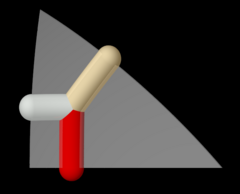 Wythoff pattern pq2| = 432| 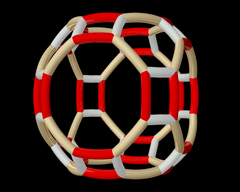 Orbit of the Wythoff pattern under the action of the full wikipedia:octahedral group. |
 The regular map {6,3}4,0 on the torus with 16 faces, 32 vertices and 48 edges. |
 Partial {7,3} hyperbolic tiling of the hyperboloid. |
 Hyperboloid rotated into Poincare perspective. |
Animation of rotation of the hyperboloid into Poincare perspective. |
